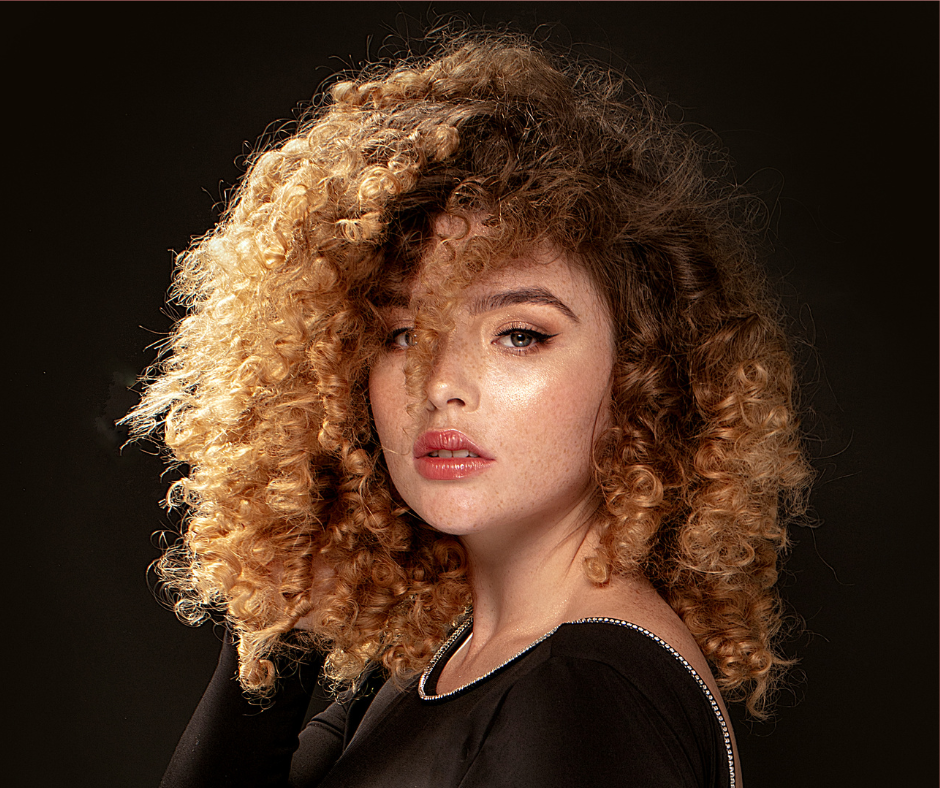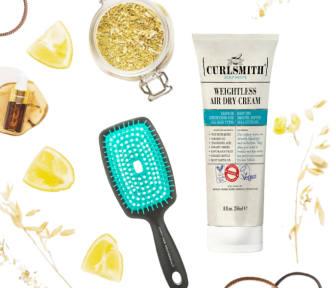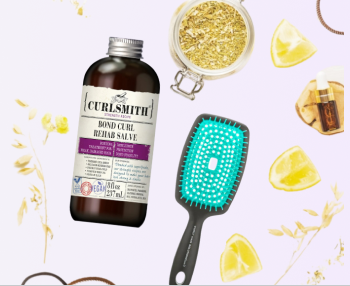Glycerin. Does the word instantly get your attention? If there’s one ingredient that seems to not get the love in the curly/wavy community, it would be glycerin.
What is Glycerin?
Glycerin is a humectant that can also known as glycerol. It is a natural compound derived from vegetable oils or animal fats. It's a clear, colourless, odorless, and syrupy liquid with a sweet taste. Note if your product has it listed as vegetable glycerin or it is a vegan-friendly product, it will not be made from animal fat.
It is used in a lot of products from hair care, skin care, and cosmetics. It can be very hard to avoid.
The thing is, glycerin is not the only humectant you will see in your curly hair products. It might be the most fickle humectant, but rarely do I ever see any concerns on social media or am I asked about any other humectant beside glycerin.
This is a partial list of the most common simple humectants that you might see in hair products:
- Glycerin/glycerol
- Sorbitol
- Propylene Glycol
- Sodium PCA
- Agave Nectar
They are all excellent moisturizers and emollients because they help your hair to retain water. An added bonus is that they also are great curl activators and enhancers.
In super humid and super dry climates (i.e., the absolute extreme ends of these measurements) people sometimes find avoiding glycerin reduces frizz. This may be because in these conditions glycerin might be overworking by pulling in more moisture to the hair, or losing it (drying) too quickly.
As a general rule, I don’t recommend the dropping of glycerin in all of your products. It usually results in dry hair because glycerin is such a great moisturizer. Avoiding glycerin in products that are rinsed out like your shampoo and conditioner is completely unnecessary. Plus, all products have different ingredients in different concentrations, so ultimately formulation is more important than one specific ingredient.
Reducing the Effects of Glycerin
If you find glycerin causes frizz or is too heavy (moisturizing) there are a few things you can do to reduce the effects of it instead of avoiding it entirely. Here are some thoughts around what ingredients can help as well as some product suggestions to improve your glycerin experience:
1. Use a Primer
Start with a primer that doesn’t have any glycerin or other simple humectants as your first styler. This product should have film-forming humectants such as:
- Plant Gels
- Proteins
- Polymers
Then the rest of your stylers - even those with glycerin - should not be as effected. Remember these ingredients work best in your styling products, the ones that stay on your hair and are not rinsed out like shampoo and conditioner.
Formulation is so, so important as I mentioned above. If your product has glycerin, but it also has film-forming humectants, proteins, and polymers (in all likelihood) it will work out fine.
Let’s talk a bit more about each of these three ingredients as these will help to prevent more water from being drawn in (high humidity/dew point) or escaping as in low humidity/dew point).
List of Plant Gels (not complete just the common ones)
- Aloe Vera
- Flaxseed
- Hydroxyethylcellulose
- Pectin
- Xanthan gum
- Guar gum
- Marshmallow root
- Slippery elm
- Carrageenan (also known as irish moss or seaweed extract, sea emollient, sea algae, sea vegetable)
- Nettle leaf tea or nettle extract
Indicators of Protein
- Hydrolyzed ________(source of protein) protein can be wheat, rice, quinoa, etc.
- Peptides
- Amino acids
Polymers
- Polyquaternium-69,70,72,11,10, 4, 16 and 28 (4, 10 and 11 can build up)
- PVA/VP Copolymer
In fact a lot of polymers would work well in high and low dew points to combat frizz. They can condition, detangle, and be film-forming. They are Curly Girl / Curly Hair Method approved.
Here are a few good primers available at Curl Warehouse that, when used even with a glycerin-containing product, can help reduce the effects of a humectant:
- Ecoslay Orange Marmalade is one of my favourites. It is protein and glycerin-free. Some can use it as a one and done and it is the consistency of a creamy gel. It is great at curl activation and scrunches out to a soft hold.
- TreLuxe Reflex Curl Styling Serum is a product that has no glycerin but has propylene glycol, protein, plant gels, and a polyquat.
- Miribel Naturals Silky Smooth Flaxseed Gel is another great choice. It has plant gels, polyquats, and is humectant-free (it contains no glycerin or other simple humectants).
- Camille Rose Curl Maker is a nice serum that is full of plant gels. It does have an oil (see more about oils below) and is protein free.
- Curl Junkie’s Curls In A Bottle is light hold serum that is glycerin-free. Propylene glycol is the 3rd ingredient but it has plant gels and polyquats.
- Flora & Curl’s Style Me Sweet Hibiscus Curl Activating Lotion offers no glycerin, but has protein, butter, oil, and emollients.
- Pretty Curly Girl's Bye Bye Frizz Serum is glycerin free with plant gels. It does contain propylene glycol but this as mentioned may not be as fickle as glycerin.
Many of the products above can be used on their own as well, so they are great for experimenting with in different climates.

2. Use an Oil
If your hair can manage oils, this can also create a barrier to slow down moisture loss. If your hair is fine and low density it might be too heavy, but like any oil start with just a few drops and experiment. Apply this like a primer under your styling products.
- Bonding Oil from Curlsmith is glycerin-free and has protein.
- Boucleme’s Revive 5 Hair Oil is multi-use and could be a great first product to protect against frizz and UVB.
3. Use a Leave-in or Cream
Last but not least, a cream or a leave-in conditioner can work as long as it is not too heavy for your fine texture or lower density hair.
- Curlsmith Weightless Air Dry Cream is a lighter leave-in conditioner. It is protein-free and glycerin-free and contains oils and butters.
- Bounce Curl's Avocado & Rose Oil Clump and Define Cream is also glycerin- and protein-free.
- TreLuxe's Untie the Knot Leave in Conditioner has protein, plant gels, and oils. It contains no glycerin but propylene glycol in position 5 in the ingredients list.
- Rice Pudding Leave in Conditioner is glycerin-free and contains plant gels. It has rice but that would be very little protein. It has pantheon lower in the ingredients list but there doesn’t seem to be a lot of science to indicate if this type of vitamin acts like a protein. Rice Pudding does have sodium PCA as its humectant in position 4 of the ingredients list but many people find this humectant far less finicky than glycerin.
- Curls Blueberry Bliss Leave-In Conditioner is glycerin free. It does have Sorbitol in 8th position so that's quite low. Protein and plant gels are included.
- Inahsi Naturals' Aloe Hibiscus Leave In & Detangler is another glycerin-free product with plant gels and oils.
- Miribel Natural's Dreamy Hair Cream is free of glycerin and full of plant gels, emollients, butter, and oil. It is also protein-free.
- Ecoslay's new Lemon Buttercream Styling Cream is glycerin free and has sodium PCA in 5th position. It has a lot of plant gels and is protein free.

How the Weather Affects Your Products and Hair
We can’t talk about glycerin and leave the weather out of the conversation. Since hair is affected by how wet or how dry your climate is here is a bit more on the buzzwords that you will hear from other blogs, on social media, and from educational influencers.
We all talk freely about the humidity being too high or too low, but the actual metric you want to keep your eye on is the dew point. What is the difference between these two? Well in simple terms:
- Dew Point = How much water the air can hold.
- Relative humidity = How much water the air is holding right now, at this temperature.
You can get the dew point from your favourite weather information site/app. I use weather.gc.ca here in Canada.
Once you know your current dew point you can use this guide to help you choose the stylers to use and how you're going to use them (i.e., with or without other products).
- Dew point below -9C is Very Dry
Use as much moisture (water) and emollients (oils, butters) as you hair can handle without over-conditioning. Many will have to expect a looser curl pattern at this dew point. You may need to limit simple humectants and add film-forming humectants (plant gels, protein, and polymers as listed above).
- Dew point -9C to -1C is Dry
- Between -1C to 4C is Iffy
- Between 4C to 16C is prime curly/wavy range
- Dew point 16C and up means high levels of water in the air
Some curls will be able to tolerate humectants at this point. Those with more porous hair may start to see humectant-induced frizz at this range, and especially so once the dew point hits 21C.
Conclusion
Remember: not everyone experiencing frizz has frizz that is caused by high and/or low dew points. Frizz can be caused by many things. Check out my blog on What is Frizz? for more information. Like everything with the Curly Girl / Curly Hair Method you need to experiment with your hair to see what works best with your curls and your environment.
In summary, how do you get great curls that don't take in too much moisture in high dew points or lose moisture in low dew points?
-
Use styling products that have humectants lower than the first 5 ingredients and/or
-
Use styling products that have film-forming humectants to help negate the impacts of these humectants (i.e. plant gels, hydrolyzed proteins and polymers) and/or
- Reach for oils, leave-in conditioners, and creams if your hair can handle the weight of these products.
References
- Science-y Hair Blog (https://science-yhairblog.blogspot.com/2012/04/seasons-are-changing-dewpoint-visual-aid.html)
- The Mestiza Muse (https://themestizamuse.com/the-humectant-glycerin/)
- Science-y Hair Blog (https://science-yhairblog.blogspot.com/2014/07/film-forming-humectants-what-they-are.html)
- Science-y Hair Blog (https://science-yhairblog.blogspot.com/2014/07/film-forming-humectants-what-they-are.html)
- Science-y Hair Blog (https://science-yhairblog.blogspot.com/2013/11/polyquat-or-not.html)








